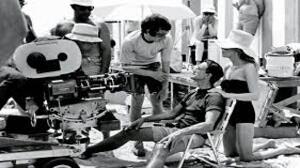Steven Spielberg (1975-1982)

In the late 1970s, Steven Spielberg redefined blockbuster filmmaking, establishing himself as a director who could marry mass appeal with technical brilliance and heartfelt storytelling. His films from this period, characterized by their groundbreaking visual effects, iconic scores, and childlike sense of wonder, captured the imagination of audiences worldwide and set the standard for modern Hollywood cinema. From the unprecedented success of Jaws to the commercial disappointment of 1941, Spielberg’s journey was one of risk-taking, learning, and constant innovation. By the early 1980s, he had proven himself a master craftsman capable of making deeply personal films that resonated on a universal level.
Jaws (1975) Jaws, simply put, made Spielberg a household name and changed the movie industry forever. Based on Peter Benchley’s novel, the story of a killer shark terrorizing a small seaside town became the first true summer blockbuster, breaking box office records and creating a new model for Hollywood’s release strategy. Spielberg’s direction is masterful, using suspense and suggestion to heighten the terror. The mechanical shark, famously prone to malfunction, forced him to rely on creative techniques—shadowy underwater shots, the ominous John Williams score—to suggest the creature’s presence, proving that less can indeed be more. The film’s pacing is impeccable, blending horror, humor, and character-driven drama. The camaraderie between Roy Scheider, Richard Dreyfuss, and Robert Shaw anchors the story, while the climactic shark hunt is a masterclass in tension and action. Jaws was more than just a box office phenomenon; it was a cultural event that forever changed the way audiences experience movies. Its success cemented Spielberg as a director capable of delivering both spectacle and substance.
Close Encounters of the Third Kind (1977) With Close Encounters of the Third Kind, Spielberg turned his gaze to the stars, crafting a deeply personal story about humanity’s yearning for connection and the mysteries of the universe. The film follows Roy Neary (Richard Dreyfuss), an ordinary man drawn to a mysterious mountain after a close encounter with alien life. Spielberg’s direction is filled with awe and wonder, using groundbreaking visual effects to bring the extraterrestrial phenomenon to life. The climactic sequence—where humans and aliens communicate through music—is both visually stunning and emotionally profound, a testament to Spielberg’s ability to blend spectacle with heartfelt storytelling. Close Encounters showcased Spielberg’s ability to tackle complex themes with sincerity and optimism, solidifying his reputation as a filmmaker who could blend the extraordinary with the deeply human.
1941 (1979) A rare misstep, 1941 is a chaotic World War II comedy that struggles to balance its slapstick humor with its ambitious scale. The film features an ensemble cast, including John Belushi and Dan Aykroyd, as they navigate a fictionalized panic in Los Angeles following the attack on Pearl Harbor. Despite Spielberg’s best efforts, the film is a tonal mess, with its over-the-top humor often clashing with its historical backdrop. The elaborate set pieces, while visually impressive, feel excessive and lack the emotional resonance that characterizes his best work. However, Spielberg’s technical prowess shines in several sequences, and the film’s ambition, though misguided, reflects his willingness to take risks. In hindsight, 1941 served as a valuable learning experience, demonstrating the importance of balancing spectacle with story.
Raiders of the Lost Ark (1981) Raiders of the Lost Ark marked Spielberg’s triumphant return to form, a thrilling adventure that paid homage to the serials of the 1930s and 1940s. Created in collaboration with George Lucas, the film introduced audiences to Indiana Jones (Harrison Ford), an intrepid archaeologist on a quest to recover the Ark of the Covenant. Spielberg’s direction is pitch-perfect, combining pulse-pounding action with moments of humor and character development. The iconic set pieces—the rolling boulder, the snake pit, the truck chase—are executed with precision and creativity, showcasing Spielberg’s unparalleled skill as a visual storyteller. Harrison Ford’s charismatic performance as Indy anchors the film, making him one of cinema’s most enduring heroes. John Williams’ rousing score adds to the film’s sense of adventure, while the script by Lawrence Kasdan balances wit and excitement in equal measure. Raiders was a critical and commercial triumph, earning multiple Academy Award nominations and becoming one of the most beloved films of all time, solidifying Spielberg’s reputation as a master of blockbuster filmmaking.
E.T. the Extra-Terrestrial (1982) E.T. the Extra-Terrestrial is Spielberg at his most heartfelt, a touching story about friendship, loss, and the power of connection. The film follows Elliott (Henry Thomas), a young boy who befriends a stranded alien and helps him return home. Spielberg’s direction is intimate and emotionally resonant, capturing the wonder of childhood with remarkable authenticity. The performances, particularly from the child actors, are natural and engaging, while John Williams’ iconic score adds an extra layer of emotion to the story. The film’s special effects, while groundbreaking for the time, never overshadow its emotional core. Spielberg’s ability to balance spectacle with humanity is on full display, making E.T. a deeply moving experience that resonates with audiences of all ages. A massive box office success, E.T. remains one of Spielberg’s most beloved works, a testament to his ability to create films that are both magical and profoundly human.
Overall Appraisal From 1975 to 1982, Steven Spielberg demonstrated an unparalleled ability to connect with audiences through films that combined technical innovation with universal themes. His work during this period not only redefined the blockbuster but also showcased his range as a filmmaker, from the suspenseful terror of Jaws to the emotional intimacy of E.T. The lessons learned from the failure of 1941 only strengthened his subsequent efforts, culminating in the near-perfect balance of adventure, humor, and heart found in Raiders of the Lost Ark. Spielberg’s films from this era are united by their sense of wonder and optimism, reflecting a filmmaker deeply in touch with his audience’s emotions. Whether exploring the depths of the ocean, the vastness of space, or the simplicity of a child’s backyard, Spielberg captured the imagination of a generation and set a new standard for cinematic storytelling.
